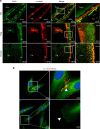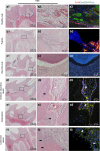Role of connexin 43 in odontoblastic differentiation and structural maintenance in pulp damage repair
- PMID: 33414369
- PMCID: PMC7791050
- DOI: 10.1038/s41368-020-00105-1
Role of connexin 43 in odontoblastic differentiation and structural maintenance in pulp damage repair
Abstract
Dental pulp can initiate its damage repair after an injury of the pulp-dentin complex by rearrangement of odontoblasts and formation of newly differentiated odontoblast-like cells. Connexin 43 (Cx43) is one of the gap junction proteins that participates in multiple tissue repair processes. However, the role of Cx43 in the repair of the dental pulp remains unclear. This study aimed to determine the function of Cx43 in the odontoblast arrangement patterns and odontoblastic differentiation. Human teeth for in vitro experiments were acquired, and a pulp injury model in Sprague-Dawley rats was used for in vivo analysis. The odontoblast arrangement pattern and the expression of Cx43 and dentin sialophosphoprotein (DSPP) were assessed. To investigate the function of Cx43 in odontoblastic differentiation, we overexpressed or inhibited Cx43. The results indicated that polarized odontoblasts were arranged along the pulp-dentin interface and had high levels of Cx43 expression in the healthy teeth; however, the odontoblast arrangement pattern was slightly changed concomitant to an increase in the Cx43 expression in the carious teeth. Regularly arranged odontoblast-like cells had high levels of the Cx43 expression during the formation of mature dentin, but the odontoblast-like cells were not regularly arranged beneath immature osteodentin in the pulp injury models. Subsequent in vitro experiments demonstrated that Cx43 is upregulated during odontoblastic differentiation of the dental pulp cells, and inhibition or overexpression of Cx43 influence the odontoblastic differentiation. Thus, Cx43 may be involved in the maintenance of odontoblast arrangement patterns, and influence the pulp repair outcomes by the regulation of odontoblastic differentiation.
Conflict of interest statement
The authors declare no competing interests.
Figures





Similar articles
-
[Inhibition of connexin 43-mediated hemichannel activity promotes odontoblast differentiation of human dental pulp cells induced by lipopolysaccharide].Shanghai Kou Qiang Yi Xue. 2024 Feb;33(1):22-29. Shanghai Kou Qiang Yi Xue. 2024. PMID: 38583020 Chinese.
-
Connexin43-containing gap junctions potentiate extracellular Ca²⁺-induced odontoblastic differentiation of human dental pulp stem cells via Erk1/2.Exp Cell Res. 2015 Oct 15;338(1):1-9. doi: 10.1016/j.yexcr.2015.09.008. Epub 2015 Sep 12. Exp Cell Res. 2015. PMID: 26376117
-
Expression of KLF5 in odontoblastic differentiation of dental pulp cells during in vitro odontoblastic induction and in vivo dental repair.Int Endod J. 2017 Jul;50(7):676-684. doi: 10.1111/iej.12672. Epub 2016 Jul 13. Int Endod J. 2017. PMID: 27334851
-
Characterization of Odontoblast-like Cell Phenotype and Reparative Dentin Formation In Vivo: A Comprehensive Literature Review.J Endod. 2019 Mar;45(3):241-249. doi: 10.1016/j.joen.2018.12.002. J Endod. 2019. PMID: 30803530
-
Odontoblasts: Specialized hard-tissue-forming cells in the dentin-pulp complex.Congenit Anom (Kyoto). 2016 Jul;56(4):144-53. doi: 10.1111/cga.12169. Congenit Anom (Kyoto). 2016. PMID: 27131345 Review.
Cited by
-
Double-Edged Sword Effect of Pyroptosis: The Role of Caspase-1/-4/-5/-11 in Different Levels of Apical Periodontitis.Biomolecules. 2022 Nov 8;12(11):1660. doi: 10.3390/biom12111660. Biomolecules. 2022. PMID: 36359010 Free PMC article.
-
Peroxisomal dysfunction interferes with odontogenesis and leads to developmentally delayed teeth and defects in distinct dental cells in Pex11b-deficient mice.PLoS One. 2024 Dec 9;19(12):e0313445. doi: 10.1371/journal.pone.0313445. eCollection 2024. PLoS One. 2024. PMID: 39652567 Free PMC article.
-
Metabolic shift and the effect of mitochondrial respiration on the osteogenic differentiation of dental pulp stem cells.PeerJ. 2023 Apr 21;11:e15164. doi: 10.7717/peerj.15164. eCollection 2023. PeerJ. 2023. PMID: 37101792 Free PMC article.
-
Histone acetylation facilitates multidirectional pulp repair through Neuregulin-1 mobilization.Stem Cells Transl Med. 2025 Jun 25;14(7):szaf022. doi: 10.1093/stcltm/szaf022. Stem Cells Transl Med. 2025. PMID: 40580029 Free PMC article.
-
Blockade of connexin43-containing hemichannel attenuates the LPS-induced inflammatory response in human dental pulp cells by inhibiting the extracellular flux of ATP and HMGB1.Front Oral Health. 2024 Dec 2;5:1496819. doi: 10.3389/froh.2024.1496819. eCollection 2024. Front Oral Health. 2024. PMID: 39687479 Free PMC article.
References
-
- Smith AJ, et al. Reactionary dentinogenesis. Int. J. Dev. Biol. 1995;39:273–280. - PubMed
-
- Lesot H, Begue-Kim C, Kubler MD, Meyer JM. Experimental induction of odontoblast differentiation and stimulation during reparative processes. Cells Mater. 1993;3:201–217.
-
- Gronthos S, et al. Stem cell properties of human dental pulp stem cells. J. Dent. Res. 2002;81:531–535. - PubMed
-
- Hu L, Liu Y, Wang S. Stem cell-based tooth and periodontal regeneration. Oral. Dis. 2018;24:696–705. - PubMed
Publication types
MeSH terms
Substances
LinkOut - more resources
Full Text Sources
Other Literature Sources
Miscellaneous

